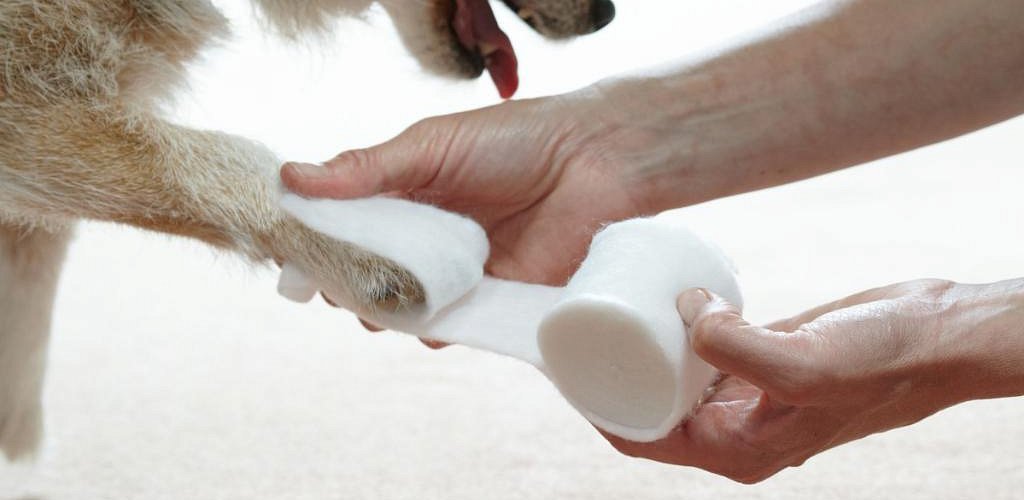What should I do if the dog is injured?

The cause of bleeding in a dog may be a wound or a disease. Injuries accompanied by blood loss, animals most often get on a walk, cut themselves on broken glass or a tin can, or as a result of a fight with relatives. Wounds and bites from hunting dogs are also possible. Sometimes this happens in accidents, when falling from a height or as a result of an accident.
The consequences of bleeding depend on many factors: the magnitude and severity of the damage, the physiological state of the dog and the volume of blood lost. Bleeding can be external and internal. If in the first case, blood flows out of the damaged vessel through a visible wound, then with internal hemorrhage, it accumulates in the body cavities: thoracic or abdominal.
Depending on which vessel is injured, arterial, venous and capillary bleeding are distinguished. Artery damage is most dangerous due to the high rate of blood loss and the inability to form a clot at the site of injury. At the same time, the blood flows out in a powerful jet, jerkily and has a bright scarlet color. When a vein is damaged, the outflow is smooth, without pulsation, dark cherry color. Capillary bleeding is most often observed when the pads on the paws are cut, when the smallest droplets of blood from the surface vessels merge into one trickle.
Arterial bleeding is a life-threatening condition and requires urgent veterinary care. However, venous, if not stopped in time, can lead to significant blood loss and death of the animal. Capillary bleeding often stops spontaneously due to vasoconstriction and the formation of a clot at the site of injury.
What should be done?
The bleeding should be stopped as soon as possible or at least slowed down. The dog should be fixed and calmed down, not allowing the animal to actively move. It is impossible to give a drink when bleeding. The place of damage to the vessel must be squeezed by hand or fingers. On the wound itself, you need to fix an absorbent layer of cotton-gauze swab, a piece of cotton cloth or a clean towel, and then apply a thick bandage. If there is a suspicion of a foreign body in the wound (glass, bullets or bone fragments with an open fracture), a bandage is applied above the bleeding site. Large vessels are squeezed in the same place: on the hind limbs, an artery is squeezed on the inner surface of the thigh, on the front paws – on the elbow bend under the armpit. With wounds in the head area, one of the jugular veins located on the sides of the neck is carefully pressed (necessarily only one). You should also know that you can not squeeze the fracture site.
When applying a tourniquet above the bleeding site, you can use a wide ribbon, belt or scarf. A thin rope is not suitable for this, as it will contribute to additional tissue damage and aggravate bleeding. After applying the tourniquet, it is necessary to loosen its tension every 10-15 minutes by squeezing the bleeding vessel manually. Otherwise, the death of the underlying part of the limb may occur, threatening further necrosis and amputation.
After that, it is necessary to take the dog to a veterinary clinic or call a doctor at home. Before examining the animal by a doctor, it is necessary to carefully monitor its general condition. Paling of the visible mucous membranes, increased heart rate and weakening of the pulse on the femoral artery are threatening symptoms. In this case, medical care should be provided within an hour and a half. When transporting an animal to the clinic, it is better to keep it lying on its back for the outflow of blood from the injured limb.
Before the doctor arrives, it is better not to treat the wound yourself, so as not to aggravate the bleeding. In the most extreme case, if severe contamination has occurred, it is possible to wash the damage area with hydrogen peroxide or furacilin solution. The hair around the wound should be cut and then a tight pressure bandage should be applied. At the same time, the dog should not be allowed to lick the place of the cut and the dressing material.
Bleeding from natural openings (nose, mouth, ears, intestines or genitourinary tract) is usually a secondary symptom and indicates some underlying disease. In this case, it is necessary to take the dog to a veterinary clinic for diagnosis and further treatment. Internal bleeding is considered the most dangerous for the animal's life, as it is very difficult to recognize at home. Hemorrhages in the thoracic or abdominal cavity almost do not appear externally. There is only paling of the visible mucous membranes and increased breathing and heartbeat. The body temperature of the animal may decrease. In such cases, emergency veterinary care is required. Only qualified medical intervention can save a dog's life with internal hemorrhage.
It is not recommended to use hemostatic and antishock drugs at home without a doctor's prescription in order to avoid serious complications. And even if the damage to the dog was insignificant, and the bleeding stopped spontaneously, you should not neglect further examination by a veterinarian and professional recommendations. It is not uncommon for a minor abrasion to lead to serious inflammation. You need to take a very careful approach to the health of your pet, and then your beloved dog will be around for many years!